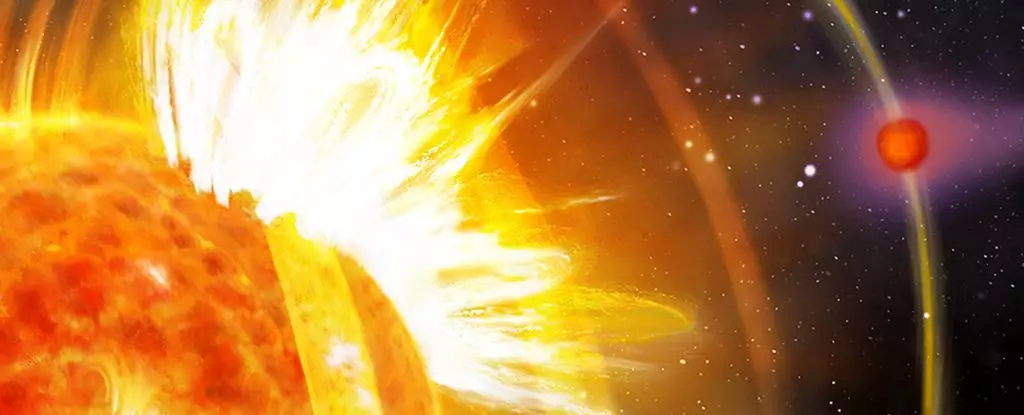In the vast expanse of space, where celestial bodies often appear isolated and independent, recent groundbreaking observations challenge this long-held assumption. The discovery of a close-in exoplanet actively disturbing its host star’s magnetic field signals a profound shift in our understanding of star-planet dynamics. Unlike the traditional view that planets are mere passive companions, some may wield considerable influence over stellar behavior, instigating violent eruptions that reshape entire planetary systems. This revelation not only deepens our insight into celestial interactions but also raises critical questions about the survival prospects of planets in such tumultuous environments.
The key player in this cosmic drama is a young, Sun-like star (HIP 67522) located approximately 408 light-years away, paired with an exoplanet roughly the size of Jupiter but with only 5 percent of its mass. Orbiting the star at a rapid pace — completing a revolution every 6.95 days — this planet’s proximity results in a magnetic interplay so intense that it disrupts the star’s magnetic equilibrium. Instead of being a benign orbiting body, HIP 67522b becomes an active participant, injecting energy into the star’s magnetic field lines and sparking a flare frenzy that transcends typical stellar activity.
This scenario exemplifies how celestial bodies in such tight orbits can serve as catalysts for massive stellar outbursts. The correlation between the planet’s position and the timing of energetic flares suggests an intricate magnetic handshake—where the planet’s magnetic field acts as a trigger for the star’s explosive release of energy. Over a period of five years, astronomers documented 15 such flare events, each seemingly synchronized with the planet’s orbital phase. These phenomena indicate that the planet’s magnetic activity is not just incidental but actively influences the star’s behavior, converting what was once thought to be a one-way stellar phenomenon into a bidirectional interaction.
Implications for Planetary Atmospheres and Evolution
The energetic outbursts resulting from such star-planet coupling have profound consequences for the orbiting planet itself. It is receiving six times more radiation than similar planets in less hostile environments, a relentless barrage that heats and strips away its atmosphere. Owing to its tumultuously inflated, “puffy” state, this planet is particularly vulnerable. The intense flare activity functions much like a stellar wind that erodes its gaseous envelope, with the potential to obliterate its atmospheric layers within a relatively short cosmic timeframe—possibly transforming it into a smaller, more barren body akin to Neptune in as little as 100 million years.
This process underscores an often-overlooked aspect of planetary evolution—stellar activity directly driven by close-in planets could precipitate atmospheric loss at velocities far exceeding our expectations. Such interactions suggest a self-perpetuating cycle where a planet’s proximity heats its atmosphere, making it more susceptible to stripping during stellar flares, which in turn influences the planet’s long-term viability. The implications are significant; worlds orbiting perilously close to their stars may be less habitable or even uninhabitable over relatively short geological timescales due to these fiery stellar interactions.
Furthermore, these findings raise uncomfortable questions about the habitability of exoplanets orbiting close to active stars. If planets can actively modulate stellar behavior, then their atmospheres—and potential for life—may be far more fragile than previously believed. The intense flaring driven by such star-planet magnetic interactions could sterilize planetary surfaces or prevent atmospheres from stabilizing altogether.
The Broader Impact on Our Understanding of Cosmic Dynamics
This newly observed phenomenon challenges the classical thought that stars are largely unaffected by their planetary companions. Instead, it paints a more dynamic picture—where the boundary between stellar and planetary influences is more blurred than previously thought. Recognizing that planets can trigger and amplify stellar flares necessitates a reevaluation of stellar activity models, especially for young, close-in systems.
The research on HIP 67522 and its planet is just the vanguard of a potential revolution in astrophysics. As astronomers expand their search for similar systems, they could uncover a population of star-planet interactions with significant consequences for planetary evolution, atmospheric retention, and even the distribution of life-supporting conditions across the galaxy. The idea that planets are not passive bystanders but active participants in their star’s magnetic and energetic behavior marks a paradigm shift—one that compels us to reconsider how we interpret stellar activity, planetary atmospheres, and the delicate balance that sustains habitability.
The next step is to scan the universe more vigorously for analogous systems, aiming to quantify how widespread and impactful these magnetic interactions might be. Doing so could reveal whether HIP 67522b is a rare anomaly or part of a broader cosmic pattern where planets and stars are locked in a magnetic tango that influences their evolution. Understanding these interactions better equips us to assess the longevity of planetary atmospheres, the potential for life, and the complex dance of forces shaping our universe’s habitable niches.

